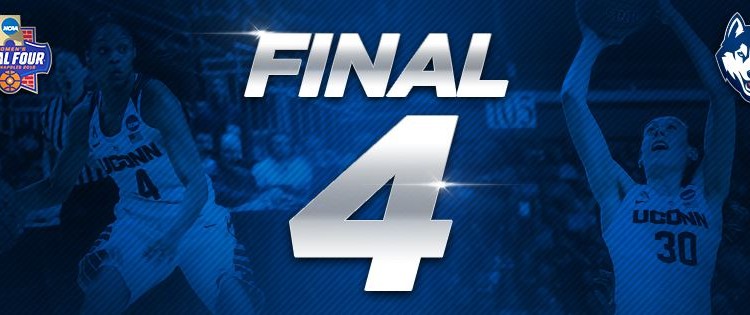Words by Ian O’Connor
Three straight national championships, nine consecutive Final Four appearances, 73 straight victories, 22 consecutive wins in the NCAA tournament and a 120-1 record over the last 121 games, with every win by double figures.
To write a record-shattering script like this seems borderline impossible, but there is one pen that is capable of writing this script, and it is wielded by UConn women’s basketball head coach Geno Auriemma, who is on a quest to win an 11th NCAA title with the program.
His team has recently been engulfed in conversation, heightened by media attention and several individuals weighing in on the program.
However, they are not congratulating them. They are not praising their accomplishments. Rather, they are saying that the team’s dominance is bad for women’s basketball.
For years, comparisons have been made between UConn women’s basketball and legendary dynasties in other sports.
They have been compared to the Boston Celtics, the New York Yankees, and most often, to John Wooden’s UCLA basketball teams. It is completely fair to declare this UConn program as a dynasty of its own, but to claim that they have negatively impacted the game of women’s basketball is like calling Los Angeles the capital city of California. If you didn’t know any better, both claims would seem to be correct.
In essence, the claims against UConn are misguided and are an insult to everyone who has passed through Storrs, Connecticut and has contributed to its current reign of dominance.
At 12:30 p.m. on March 31, I stood outside Gampel Pavilion alongside other fans of the team, whose ages ranged from eighteen to seventy-eight years old, in anticipation to see their departure to Indianapolis for the Final Four.
Despite my interest in seeing the players before they left, something else caught my eye. Behind the crowd of fans cheering and taking pictures, in front of the Jonathon Husky statue, was a message written in chalk on the sidewalk. It was in the form of a letter, and it was addressed to the women’s team.
The heartfelt message described, from a fan’s perspective, how the team is “improving the game of women’s basketball with every drop of sweat,” and how they are “an inspiration to so many young girls and basketball programs around the world.” It was signed, “Love, One dedicated fan on behalf of millions.” (There was also a postscript calling freshman guard/forward Katie Lou Samuelson a “goddess,” but that’s not really relevant; although it did elicit a chuckle from me.)
Unfortunately I cannot project how many people noticed and read that message, and I am nearly certain that none of the players noticed it either, but regardless the message conveys one of the many things that UConn has contributed to the women’s game: increased interest.
The night before the rally, I found myself taking a rare midnight walk around campus to clear my mind. With the excitement of March Madness in full swing, I needed a chance to unscramble my thoughts. I walked without any direction or destination, and eventually followed my feet all the way to the locked doors of Gampel, the nucleus within the capital of the basketball world. It was now 1:30 a.m., and except for a few late night wanderers no one was around.
And neither was the chalk.
I didn’t see the message until early the next morning, which means that one anonymous student woke up, knelt down outside on Hillside Road, and transcribed their feelings onto the sidewalk between 2 a.m. and 6 a.m. It was a weeknight, and that student likely had classes, homework, sleep and other responsibilities to catch up on, but instead pushed it all aside to write a message in chalk that likely wouldn’t reach its intended audience. And for what reason?
People are finally starting to respect and follow the women’s game, and UConn is the leader of this movement.
According to John McTigue of ESPN, “ratings for the first two rounds of the women’s NCAA tournament were up 46 percent from last season. UConn’s 60-point blowout of Mississippi State was the most watched women’s game of the Sweet 16 (0.76 metered market average). The ratings only went up for UConn’s victory over Texas in the Elite Eight (1.06). Also of note, the regular-season game between UConn and Notre Dame on Dec 5 (1.53 metered market average) out-rated the Pac-12 football championship (1.25).”
The complaints from the media and sports writers such as Dan Shaughnessy, whose post on Twitter after UConn’s 98-38 win against Mississippi State in the Sweet Sixteen ignited this conversation, express the opinion that UConn is overly dominant.
Only a select few teams can compete with them, and usually by halftime most games have already been decided and the final margin of victory ends up lopsided. Some have compared watching their contests to watching a movie when you already know the ending, but the overarching claim that they are ruining women’s basketball is shortsighted.
UConn women’s basketball is far more than an NCAA powerhouse; it represents an ideal.
The program’s success models what every other program aspires to achieve, and the players model what many young girls playing high school basketball aim to become. Not many girls at the high school level can compete with the talents that seniors Breanna Stewart, Moriah Jefferson, and Morgan Tuck possess, but the fact that such talent exists inspires girls around the world to work their hardest, hoping someday they too can reach a comparable level of talent.
With UConn as the clear number one team in the country, it is every women’s college basketball team’s goal to beat them and overthrow them. Of course, in order to make this a possibility, other teams must improve, and this year’s tournament results have indicated such improvement.
Lack of parity in the women’s game has long been a complaint, with the #1 seeds expected to reach the Final Four every year. However, UConn is the only #1 seed to reach Indianapolis. The other top seeds, South Carolina, Notre Dame, and Baylor, have all lost.
#2 Oregon State, #4 Syracuse, and #7 Washington are the teams that have instead punched their tickets to the Final Four for the first time in each school’s history. In a sport without parity, a #2 seed can advance this far into the tournament, but a #4 and a #7 seed making it this far contradicts that.
Like UConn, these teams did not make it to Indy as mere flukes.
These are four teams that have worked extremely hard all year and continued to improve throughout the regular season and the postseason. The increase in bracket busters and the rise of the lower seeds this March are, in part, a direct result of UConn raising the bar for women’s college basketball. They continue to show what intense practice every day can lead to.
There is also an even more direct connection between UConn and another team that will be playing in Indianapolis, but for the Division II championship.
Lubbock Christian University (34-0), a small university from Lubbock, Texas, faced UConn in an overlooked-preseason game on November 2 at the XL Center in an important step in their quest for perfection. UConn may have won 95-39, but the experience that the LCU gained from that seemingly meaningless game is beyond compare.
As LCU’s head coach Steve Gomez and All-American point guard Nicole Hampton have expressed, UConn represents the highest standard for the game, and being given the opportunity to compete with them has driven them to reach similar heights.
Although this UConn team is writing history by achieving feats that no other team has accomplished before, that is not to say that other teams are incapable of such achievements.
UConn doesn’t do anything that other teams cannot. Their success is truly a testament to the maximum effort that every player brings to both games and practices every day. To say that the impact these players have on women’s basketball is negative and unappreciated is a harsh claim to make.
What they are doing is historic, and they should be admired for how much they’ve done to reach this point. Their willingness to be team players and their strong work ethic are the factors that put UConn into a league of their own.
After their Sweet Sixteen blowout, Mississippi State head coach Vic Schaefer said that “what separates them is, there’s lots of great teams across the country that have a lot of All-Americans, coach Auriemma gets the most out of his. He doesn’t let them settle. He develops them to the fullest.”
Auriemma’s never-satisfied attitude is one of the reasons why his teams never stop improving and why winning one championship is always a step toward a second, and a third, and even higher goals.
However, the current team still has two challenging steps ahead of them.
Although many people would be willing to hand the championship trophy to UConn right now, there will always be a chance for an upset. Auriemma has said that, no matter how successful his teams are or how much his team may be favored in a matchup, he still wakes up “as tortured or as nervous as I was in any other year, in any other tournament game.” The other three teams in the Final Four may be unexpected finalists, but they’ve put in just as much work into getting to this point as UConn, and their goal is to win a championship too.
Breanna Stewart is just two wins away from accomplishing the record-breaking goal of winning four straight national championships that she set for herself when she came to UConn. The second-to-last step on the stairway to perfection will come Sunday, April 3, at 6 p.m. in the team’s matchup against Oregon State (32-4). The Beavers are coming off of a thrilling upset of the #1-seeded Baylor Bears.
The winner will play on either Syracuse or Washington, the second national semifinal game, on Tuesday, April 5, with the 2016 NCAA title on the line.
WHUS will have full coverage of the Final Four beginning Sunday evening.
Stay tuned on our Twitter @WHUSSports and on the radio, 91.7FM | fm.whus.org


